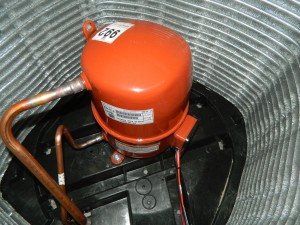10. Put the air conditioners lid back on and be aware of the condenser motor wires, run them through to the electrical panel just like they were before and be sure they do not get crimped or pinched anywhere.
Once all your screws are back in the lid.
Go back to your vacuum it’s time to check where we’re at.
By now you should be at or real close to 500 microns.
Once you reach 500 microns close the hose leading to the pump and shut off the vacuum pump.
Let it sit for 15 minutes
While you let the machine sit, you should go through and double check all you’re wiring. C-R-S your capacitor, contactor and the condenser motor. Also verify the motor spins and the blade does not hit anything like wires maybe.
- After 15 minutes has elapsed if your microns rose above 1000 you have a leak so find the leak fix it and re-vacuum.
- If you have trouble locating the leak try visiting step 21 for help.
- If your microns raise some but stopped rising and stabilized below 1000 then you’re ok the rise was just moisture boiling off into a vapor so continue down the page.
Ok, now you’re stabilized below 1000 microns, let’s re-charge the system.
Hook up the recovery jug full of r-22 to the gauges as shown in diagram 8-A open the gauges and tank to allow Freon to flow to the air conditioner. Let it drink all it can and when it stops or slows to the point that it seems pointless. Close down both dials suction and high side on the gauges.
Now put your amp probe onto the common wire for the compressor and turn it on then set it to AAC so we can watch the compressors starting amps.
Plug in disconnect and turn on air conditioner.
The new compressor should turn on and pull less than 3o amps, if it does continue charging. But, if it does not start, go back and find out where you miss-wired the compressor. Or, if it pulls over 30 amps on start, you need to install a hard start kit in step 16.
Now that the new compressor is running were in the clear and home stretch.
You’ll notice the compressor is still low on charge, open your suction gauge to charge the system through the suction only.

